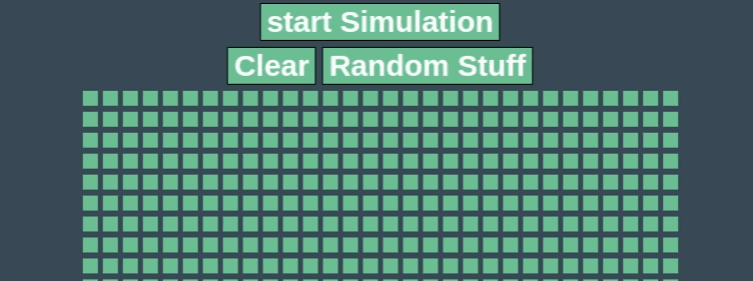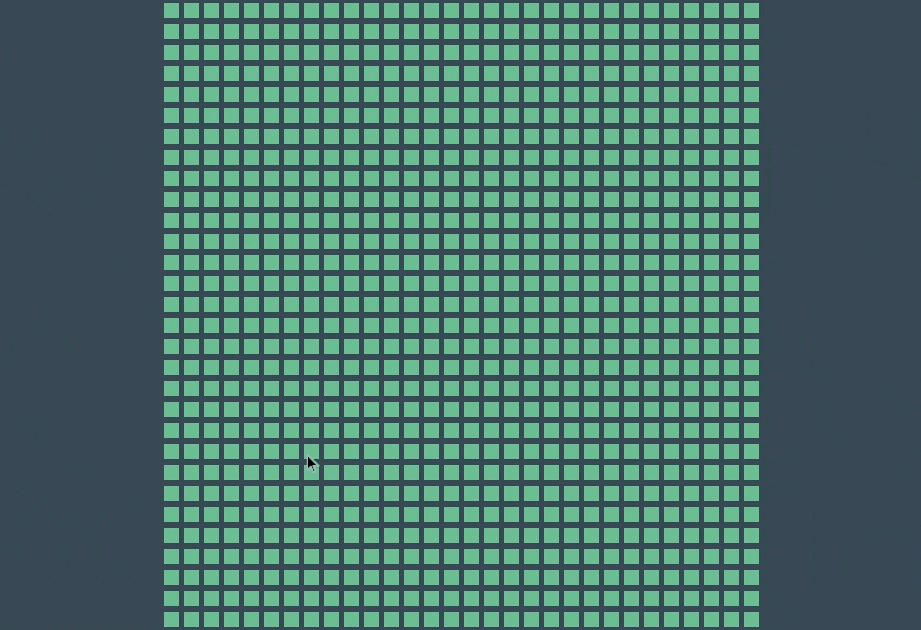React: Conway's Game of Life.

Utkarsh Yadav
Posted on April 11, 2021

Table of Content
- What is Conway's Game of Life
- Rules of the Game.
- Coding out the simulation using React
- CodeSandBox Playground
What is Conway's Game of Life
The Game of Life, also known simply as Life, is a cellular automaton devised by the British mathematician John Horton Conway in 1970. It is a zero-player game, meaning that its evolution is determined by its initial state, requiring no further input. One interacts with the Game of Life by creating an initial configuration and observing how it evolves.
View full details for the Game here
Rule of the Game
- Any live cell with fewer than two live neighbors dies, as if by underpopulation.
- Any live cell with two or three live neighbors lives on to the next generation.
- Any live cell with more than three live neighbors dies, as if by overpopulation.
- Any dead cell with exactly three live neighbors becomes a live cell, as if by reproduction.
Coding out simulator using React
Generating Empty Grid (our first task)
- The total number of
Rowandcolumnsfor the grid is to be set initially.
Note: Totally depends as per the requirement. The best is to use 30/30.
const numRows = 30;
const numCols = 30;
const generateEmptyGrid = () => {
const rows = [];
for (let i = 0; i < numRows; i++) {
rows.push(Array.from(Array(numCols), () => 0));
}
return rows;
};
Explanation:
- we used Array
rows []length ofnumRows: 30 - For every row index we are pushing
numCols: 30columns. - This function will be later used as a clear function to clear, to set the grid to empty.
[ {1, 2, 3, ...., 30},
{1, 2, 3, ...., 30},
.
.
30th row ]
Putting Random stuff on the grid
Requirement: Button and funtion
- Creating Function
generateRandomStuff()
const generateRandomStuff = () => {
const rows = [];
for (let i = 0; i < numRows; i++) {
rows.push(
Array.from(Array(numCols),
() => (Math.random() > 0.5 ? 1 : 0))
);
}
return rows;
};
- In this function, we are actually randomizing the column's number and choosing random columns in each row and if the
Math.Random() value for the columns is greater than 0.5we put that1: black else0:cleared;
State management for setting Random Stuff and clearing the stuff from the grid
const [grid, setGrid] = useState(() => {
return generateEmptyGrid();
});
- using use State: we can do the state management for the grid.
- Initially: The grid is set to empty.
Generate Random stuff: TO do this we will call for the function
const generateRandomStuff = () =>
and set it in grid : setGrid(generateRandomStuff())
<button
onClick={() => {
setGrid(generateRandomStuff());
}}>
Random Stuff
</button>
Generate Empty Grid: To do this we will call for the function
const generateEmptyGrid = () =>
and set it in Empty the grid : setGrid(generateEmptyGrid())
<button
onClick={() => {
setGrid(generateEmptyGrid());
}}>
Clear
</button>
Running Simulation (Logic) :)
- For the simulation we need some preprocessing.
const redundant = [
[0.1],
[0, -1],
[1, -1],
[-1, 1],
[1, 1],
[-1, -1],
[1, 0],
[-1, 0]
];
an array is taken with all steps, where we can move
- We can move in all eight directions in the grid.
const [Simulation, setSimulation] = useState(false);
const runningRef = useRef(Simulation);
runningRef.current = Simulation;
const runSimulation = useCallback(() => {
if (!runningRef.current) {
return;
}
setGrid((g) => {
return produce(g, (gridCopy) => {
for (let i = 0; i < numRows; i++) {
for (let k = 0; k < numCols; k++) {
let neighbors = 0;
redundant.forEach(([x, y]) => {
const newI = i + x;
const newK = k + y;
if (newI >= 0 && newK >= 0 && newI < numRows && newK < numCols) {
neighbors += g[newI][newK];
}
});
if (neighbors < 2 || neighbors > 3) {
gridCopy[i][k] = 0;
} else if (g[i][k] === 0 && neighbors === 3) {
gridCopy[i][k] = 1;
}
}
}
});
});
setTimeout(runSimulation, 100);
}, []);
- we will make a state
simulationandsetStimulationwhich will be initiallyfalse. and will be triggered totrueusing the button. const runSimulation = useCallback(() =>{}: here we will be using callback function.-
Logic:
- we will traverse the grid from index {0,0} to {numRows,numCols}
- Take a counter for the
neigbours.
What we exactly want is:
- if there is a cell in the grid which is
setwith exactly2or3neighbors in any of the direction. - if there is a cell in the grid that is not
setand has threeset or liveneighbors becomeset or live. - All other cells that are
set or liveare now set todead or unset, whereas allunsetwill remainunset.
redundant.forEach(([x, y]) => {
const newI = i + x;
const newK = k + y;
if (newI >= 0 && newK >= 0 && newI < numRows && newK < numCols) {
neighbors += g[newI][newK];
}
});
- we will move in 8 directions from
redundant array - following the above rule we have written, three cases.
After completion of the simulation, we run the function once after the interval of time.
For this we use setTimeout(runSimulation, 100);
- Button for the simulation.
<button onClick={() => {
setSimulation(!Simulation);
if (!Simulation) {
runningRef.current = true;
runSimulation();
}
}} >
{Simulation ? "Stop" : "start"} Simulation
</button>
Note: Using
immerfor mutating the state.
If you like the content. kindly let me know.
Happy Coding.

Posted on April 11, 2021
Join Our Newsletter. No Spam, Only the good stuff.
Sign up to receive the latest update from our blog.


